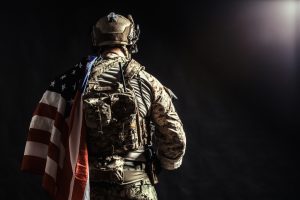
Army Rangers and Green Berets are two of the most elite forces in the U.S. military. When comparing the Army Rangers vs the Green Berets, many see two groups of highly skilled soldiers, but their roles are fundamentally different. Both units are legendary for their toughness and skill, and they are critical components of the U.S. Army Special Operations Command (USASOC).
While they share a home in the Army’s special operations community, their missions, training, and core identities showcase distinct differences. Understanding these operational differences is important to appreciating the specific capabilities each force brings to the battlefield. One is a surgical strike force, while the other is a force multiplier, specializing in unconventional warfare.
Army Rangers vs Green Berets Table of Contents:
- Army Rangers: The Army’s Premier Light Infantry Force
- Green Berets: The Army’s Special Forces
- Key Differences: Army Rangers vs Green Berets
- Similarities Between Rangers and Green Berets
- Career Paths and Opportunities
- Physical Fitness Standards
- Historical Significance
- Conclusion
Army Rangers: The Army’s Premier Light Infantry Force
The 75th Ranger Regiment is the U.S. Army’s premier light infantry force. They are a rapidly deployable unit that specializes in joint special operations raids and forcible entry missions. The modern Ranger Regiment is a direct descendant of elite infantry units from War II and the Korean War.
The Ranger motto, “Rangers Lead the Way,” captures their function as the tip of the spear. The men of the 75th Ranger Regiment are often the first to engage the enemy, conducting complex assault operations to seize key terrain, such as airfields. They are a lethal, agile, and flexible force, capable of executing a wide range of missions.
Ranger Training and Selection
The path to becoming an Army Ranger is exceptionally demanding. The selection process begins with the 8-week Ranger Assessment and Selection Program (RASP). This course rigorously tests candidates’ physical and mental fortitude to determine if they are suitable for service in the 75th Ranger Regiment.
RASP is divided into two phases. The first phase tests candidates’ physical abilities and foundational military skills under extreme stress. The second phase focuses on advanced tactics, including airborne operations and marksmanship, that are hallmarks of the Ranger Regiment. Those who complete the demanding training courses earn the tan beret and are assigned to one of the Ranger Battalions.
It’s important to distinguish RASP from Ranger School. While RASP is the entry requirement for the 75th Ranger Regiment, Ranger School is a separate leadership course that is open to soldiers, marines, sailors, and airmen from across the military. Graduating from Ranger School earns a soldier the prestigious Ranger Tab, but does not make them a member of the 75th Ranger Regiment.
Ranger Missions and Capabilities
The Rangers’ primary mission is direct action. They are masters of direct action raids, ambushes, and airfield seizures against high-value targets. Their operations are characterized by speed, precision, and overwhelming firepower.
A key capability of the Ranger Regiment is its ability to deploy anywhere in the world with just 18 hours’ notice. This readiness makes them a vital, quick-reaction force for the National Command Authority. Whether conducting air assault operations from helicopters or parachuting from planes, Rangers are trained to operate in any environment as a world-class light infantry force.
Green Berets: The Army’s Special Forces
Green Berets are the U.S. Army’s special forces, specializing in unconventional warfare and counterinsurgency operations. They are officially known as the United States Army Special Forces, but they earned the nickname “Green Beret” from the distinctive headgear they wear. Their official motto is “De Oppresso Liber,” a Latin phrase meaning “To Free the Oppressed.”
These soldiers are the military’s experts in training and leading foreign military and paramilitary forces. Their role often involves long-term deployments where they build rapport and work alongside partner nations. The Green Berets’ special capabilities are centered on their deep understanding of language and culture.
Green Beret Training and Selection
The Green Beret training pipeline is one of the longest and most mentally challenging in the entire U.S. military. The journey starts with the 24-day Special Forces Assessment and Selection (SFAS). This course, held at Fort Bragg, North Carolina, is designed to assess whether a candidate possesses the baseline physical and mental traits, particularly intelligence and problem-solving skills, required for special forces.
Candidates who pass the grueling forces assessment are selected for the Special Forces Qualification Course (Q Course). The Q Course is a multi-phase, lengthy program that can last from 6 months to over a year, depending on the soldier’s assigned specialty. It includes advanced training in small unit tactics, demolitions, weapons, communications, and medicine.
A major component of the beret training is foreign language and cultural awareness. The culmination of the Q Course is an exercise called Robin Sage. The Robin Sage exercise is a large-scale, mock guerrilla war scenario where students must apply all their skills to train and lead a guerrilla force in a fictional country, a final test before earning their Green Beret.
Green Beret Missions and Capabilities
The primary mission of the Green Berets is unconventional warfare. This involves training, advising, and leading indigenous forces in guerrilla warfare against hostile governments or occupying powers. They also specialize in foreign internal defense (FID), which is helping friendly governments protect themselves from subversion, lawlessness, and insurgency.
Beyond these core tasks, Green Berets conduct a wide range of operations, including direct action counter-terrorism, special reconnaissance, and counter-proliferation. They operate in small teams, typically 12-man units called Operational Detachments Alpha, or ODAs. This small team structure allows for flexibility and deep integration with local forces.
Key Differences: Army Rangers vs Green Berets
While both are elite special operations units, the Rangers and Green Berets have distinct roles that define them. Their mission, training, and operational structure highlight these operational differences. Understanding these is essential to appreciating their specific contributions to national security.
The Rangers are the sledgehammer, used for short-duration, high-intensity direct action raids. The Green Berets are the scalpel, specializing in long-term missions that require cultural finesse and working by, with, and through foreign partners. These distinct differences ensure the U.S. Army has the right tool for any given special operations scenario.
| Attribute | Army Rangers (75th Ranger Regiment) | Green Berets (U.S. Army Special Forces) |
|---|---|---|
| Primary Mission | Direct Action (Raids, Airfield Seizures, Capturing High-Value Targets). | Unconventional Warfare & Foreign Internal Defense. |
| Unit Size | Larger units, typically operating at the platoon or company level. | Small teams of 12 operators (Operational Detachments-Alpha or ODA). |
| Training Length | Shorter but intense. The Ranger Assessment and Selection Program (RASP) is 8 weeks. | Longer and more academic. The Special Forces Qualification Course (Q Course) can take over a year. |
| Core Skills | Advanced light infantry tactics, airborne and air assault operations, forcible entry. | Language proficiency, cultural awareness, teaching, advising, guerrilla warfare. |
| Deployment Style | Rapid, short-duration deployments for high-impact missions. | Long-term deployments, often embedded with local forces. |
Cultural Focus
The Green Berets’ mission success is heavily dependent on language skills and cultural awareness. A Green Beret assigned to a special forces team might spend years mastering a foreign language and understanding the intricate social dynamics of a region. The team room of an ODA is often filled with maps and cultural notes about their area of operations.
This is less of a central focus for the Ranger Regiment. While Rangers are professional and disciplined, their mission set prioritizes combat tactics and rapid execution over deep cultural immersion. Their focus is on striking a target with lethal efficiency and then extracting.
Similarities Between Rangers and Green Berets
Despite their differences, Rangers and Green Berets share the common bond of being elite warriors in the Army’s special operations family. Both units start with rigorous entry requirements and a selection process that pushes applicants to their absolute limits. The shared foundation of special operations preparation builds soldiers of incredible resilience.
Both forces require extreme physical conditioning and mental toughness. They are staffed by soldiers who are masters of their craft, possessing advanced combat skills far beyond those of a conventional soldier. Both Rangers and Green Berets are expected to operate effectively in the most austere and dangerous environments on Earth.
They also frequently work together on missions, alongside other special operations units like the Navy SEALs and Marine Corps Raiders. A common scenario involves Rangers seizing an airfield through a direct action raid, creating a secure area for Green Berets to fly into and begin their unconventional warfare or foreign internal mission.
Career Paths and Opportunities
Both the 75th Ranger Regiment and U.S. Army Special Forces offer rewarding career paths within Army special operations. For a young soldier, the choice between them often depends on personal aptitude and mission preference. Many soldiers who follow military news dream of joining one of these prestigious units.
It is not uncommon for a soldier to serve in the Ranger Regiment for a few years before attending the Special Forces Assessment. This path provides a strong foundation in direct action and infantry tactics before moving into the more complex world of unconventional warfare. This combination of experience makes for an exceptionally well-rounded special operator.
Physical Fitness Standards
Both units demand peak physical conditioning, but the physical tests for candidates differ slightly, reflecting their different mission sets. The training requirements for both are a significant step up from the regular Army. The selection process tests candidates’ physical limits repeatedly.
Ranger Physical Fitness Test
The Ranger Assessment and Selection Program has its standards. It includes events like a 5-mile run in under 40 minutes, a 12-mile ruck march with a 35-pound rucksack in under 3 hours, and the Ranger Physical Fitness Test. The entire selection program is one long physical test.
Green Beret Physical Fitness Test
The Special Forces Qualification course requires candidates to meet a higher standard on the Army Combat Fitness Test (ACFT). SFAS itself is a crucible of physical challenges, including long-distance land navigation courses and team events that carry heavy objects over miles of rough terrain. It tests endurance and strength over extended periods.
Historical Significance
Both the Army Ranger and the Green Beret have a rich history woven into the fabric of the U.S. Army. Their legacies were forged in the most difficult conflicts the nation has faced. They are iconic symbols of American military might.
Ranger History
The lineage of the Army Rangers goes back to colonial units in the French and Indian War. The modern Ranger battalions were formed during War II, famously scaling the cliffs of Pointe du Hoc on D-Day. Their reputation for courage under fire has been solidified in conflicts from the Korean War to modern-day operations raids.
Green Beret History
The U.S. Army Special Forces were officially established in 1952 by Colonel Aaron Bank, a veteran of the OSS in War II. President John F. Kennedy was a major advocate for the force and authorized their now-famous green beret. They rose to prominence during the Vietnam War, conducting covert operations and working with indigenous tribes.
Conclusion
The comparison of Army Rangers vs Green Berets highlights two very different, but equally vital, forces within the U.S. Army special operations community. The 75th Ranger Regiment excels as a premier light infantry force, specializing in large-scale direct action. They are the forced-entry experts of the Army’s special forces.
In contrast, the Green Berets are masters of unconventional warfare and foreign internal defense. They work in small teams, building relationships and empowering partner forces through their expertise in language and cultural awareness. Their work is often quiet and long-term, happening far from the headlines.
Both units are composed of the most dedicated and professional soldiers in the military. Whether it is the Rangers leading the way on a high-stakes raid or a Green Beret advising a foreign partner, both of these elite forces stand ready to defend the nation’s interests around the globe.
